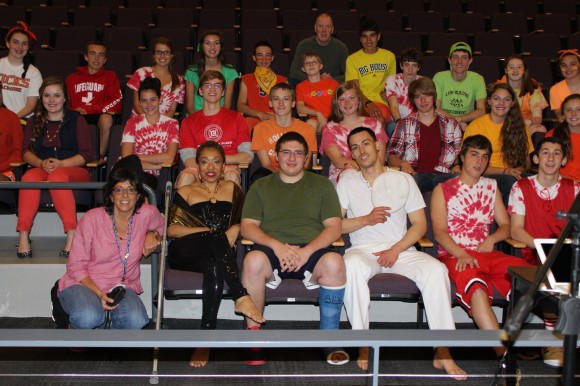
Editor’s Note: On Friday, April 26, Yesenia Fernandez-Selier and Hunter Houde, co-founders of Global Rhythms-Cuba, presented two sessions on the history of Cuban dance and music, which included a combination of lecture, dance instruction and dance performance, to students at Lyme-Old Lyme High School. Our intern, Lindsey Knepshield, was in the audience — this is her personal account of the experience.
The United States is not the only melting pot in the world and, after watching the workshop presented by Global Rhythms-Cuba, I am not even sure it is the best one. Last Friday, speakers Yesenia Selier and Hunter Houde deftly showcased Cuba’s rich and varied culture—most specifically, their dance culture in a presentation to students studying Spanish at our school.
With both African and Spanish roots intertwined so closely, a new identity has been shaped, one unique to Cuba itself. Many people know the electric slide, or the cha cha, or the salsa, but how many know the history behind them? A history that, you guessed it, begins in Cuba.
And that’s the goal of Global Rhythms-Cuba, and, more specifically, of its creators—to educate the public on Cuban culture and dance.
Yesenia Selier, is not only a superb dancer; she is also a phenomenal educator. Born in Havana, Cuba, Selier attended her city’s university to achieve a B.A. in Psychology before going to New York University and receiving an M.A. in Latin American Studies. She has taught dance to students ranging in ability from beginner to expert, and is both passionate and erudite about Afro-Cuban culture.
Hunter Houde, whose mother works in Lyme-Old Lyme High School, went to the University of Vermont (UVM) with a strong martial arts background. While at UVM, he joined their Salsa and Swing Society, sparking a passion for Latin dance. Moving to New York City to teach dance, he met Yesenia at an Afro-Cuban workshop she was conducting. Shortly thereafter, they began to work together.
Recently they created Global Rhythms-Cuba as a vehicle to bring their passion for Afro-Cuban dance to a wide audience. And that brings us to last Friday, when I attended their workshop at Lyme-Old Lyme High School.
Beginning with the African slave trade that brought her ancestors to Cuba and ending with pictures of modern Cubans dancing the Rumba in their neighborhoods, Selier was able to condense a country’s history into a PowerPoint presentation that kept her audience interested and informed.
Then it was time to dance.
Selier and Houde taught us easily followed — but not easily done — salsa steps. Students and faculty alike began with a struggle and an awkwardness that eventually gave way to a semi-adept understanding, though not without some missteps and giggling.
Next, Selier and Houde performed a variety of traditional Afro-Cuban dances, including the Oshan-Yoruba dance celebrating a deity (known as an Orisha) of the Yoruba religion. Oshan is the spirit of love, intimacy, beauty, wealth and diplomacy. Selier had the entire room transfixed as she danced in the traditional yellow dress favored by Oshan-Yoruba performers.
In the final minutes of the workshop, one brave student raised his hand after the performances had garnered its well-deserved applause. “Can we dance more?” he asked, prompting cheers from classmates. Selier laughed. “Of course!”
And so we danced.
More from the editor: Global Rhythms-Cuba is a dance and cultural organization whose mission is to use Afro-Cuban music and dance as a means to bridge the cultural past and present. By offering education about the traditional Afro-Cuban roots of many popular dances, they hope to create a better understanding of the source of inspiration for the music and dance and ultimately a stronger connection between cultures. The lecture at Lyme-Old Lyme High School was presented in Spanish, challenging the students’ listening and comprehension skills.
Students learned about the blending of cultures on the island nation of Cuba throughout its history. After more than 200 years of Spanish colonization, the English captured Havana during the eighteenth century and began the cultivation of sugar cane. The demand for labor to operate sugar and tobacco plantations and livestock farms led to the growth of African slavery and eventually to the resulting unique mix of cultures that created Afro-Cuban music and dance.
Students watched films of traditional Cuban folkloric dances and learned the significance of those dances to the people who practice them. To illustrate the development of modern popular dances, students viewed films of Cuban music and dance leading up to the present day with a clip of a Rhumba dance that has elements very similar to modern hip-hop dance.